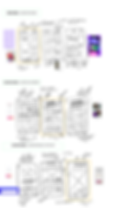FIND YOUR
PEOPLE
MY ROLES
UX / UI DESIGN
TOOLS
FIGMA
PROCREATE
OTTER.AI
POP
TIME
8 WEEKS

PROBLEM
Who is the Mayor of your city?
Who are your city commissioners? What's their role?
If you don't know - It’s ok, I had no idea either.
We are not civically engaged at a local level. Users do not know who makes the decisions or where public money is spent. Users want to make an impact in their communities but have no idea where to begin, or if they even have the voice to create positive change.
GOAL
Create a digital solution to help users access and engage in opportunities that will increase civic involvement at the local level.
Find Your People empowers users to engage in local government so that they can better shape their future, by connecting them to like-minded community actors and issues that they hold close to their hearts.
Learn and create impact by doing what you love. 💕

METHODOLOGY
DESIGN THINKING
STEPS TO TAKE
I followed the Design Thinking Methodology to better understand why users perform as they do and to use these findings to create a better experience.

1.
EMPATHIZE
SECONDARY
RESEARCH
IDENTIFYING THE PROBLEM
Local governments make most decisions that affect our daily lives. Including but not limited to public services, school budgeting, parks and recreational services, transportation. Yet, we do not engage at a local level.
To promote greater participation in local government, we can use technology to broaden public engagement, leading to local decisions that better reflect community needs and aspirations.
WHAT'S THE PROBLEM?
IDENTIFYING THE PROBLEM
Local governments make most decisions that affect our daily lives. Including but not limited to public services, school budgeting, parks and recreational services, and transportation. Yet, we do not engage at a local level.
To promote greater participation in local government, we can use technology to broaden public engagement, leading to local decisions that better reflect community needs and aspirations

60%
National
presidential elections

30%
State
mayoral elections

10%
Local
municipal & county elections
YOUTH CIVIC
ENGAGEMENT
GAP
IDENTIFYING THE PROBLEM
Research suggests that young adults between the ages of 18 and 29 are the age group that is least engaged in local government or civic engagement activities. This group is often referred to as the "youth civic engagement gap." Today, this group is referred as Gen Z.
Therefore, as the future generation, I want to empower Gen Zers (ages 18-26) to be todays trend setters and trailblazers in creating a positive impact in their communities.
BUT, WHY DOES IT EVEN MATTER?
IDENTIFYING THE PROBLEM
After conducting competitive research, I discovered that there are no current initiatives or digital solutions targeted towards young adults that address political issues that impact their communities. There is no one place for users to discover new happenings, learn about current issues, or safely connect with the community. This space is needed for users to have representation, create impact and build a community.

Representation
Underrepresented voices are taken into account.

Impact
Power in the decisions that have direct impact in lives.

Connection
Connect with others, creating a sense of belonging!
DESIGN CHALLENGE
How might we encourage meaningful interaction between residents and government officials so that local communities can better shape their future?
WELL, WHAT DO WE THINK WE KNOW?
ASSUMPTIONS
Enthusiasm:
Young adults aren’t enthusiastic about local politics.
Impact:
Young adults believe they have no voice / power.
Accessibility:
Young adults don’t know where to find information.
Time:
Young adults are too busy & don’t have time to be engaged.
Knowledge:
One of the main deterrents for young people to not participate is lack of knowledge.
Conflict:
Young adults do not want to engage because of fear of creating conflict or starting an argument.
HYPOTHESIS
IDENTIFYING THE PROBLEM
Created a Hypothesis Statement to describe how the design intervention will benefit identified users, and desired outcomes will be achieved.
I believe young adults do not engaged in local government because they believe they lack the knowledge.
I will know I’m right when I see the following feedback from the market:
At least 3 out of 5 interview respondents confirm they do not engage because of the lack of knowledge.
PLAN FOR SUCESS
PRIMARY RESEARCH PLAN
Methodology:
Will be using interviews as a decontextualized method of research to discuss in depth what the participants think about the topic in question. This will also help redefine the problem statement and “How might we encourage meaningful interaction between residents and government officials so that local communities can better shape their future?”
Goals & Objectives:
-
Understand the key motivations for bettering the community.
-
Understand the general attitudes towards local politics and civic engagement.
-
Understand the general attitudes towards digital engagement.
Participant Criteria:
Age: 18-26
Currently lives in the U.S
American Citizen
Believes in doing good
Predefined interview questions to structure the generative user interviews including a warm up, general and specific open-ended questions, and an interview wrap up section.
Sample Questions:
What are your thoughts on government? (motivations)
Have you tried to engage or learn about local politics? (behaviors)
What are some challenges when trying to engage? (pain points)
What would be a better way for you to get involved in your community? (solutions)
2.
DEFINE
REAL VOICES,
REAL PAIN POINTS & MOTIVATIONS
KEY THEMES & INSIGHTS
After the interviews were conducted, I created an Affinity Map to get a deeper understanding of the users pain points, motivations and behaviors. I identified key themes and user insights to then determine design intervention.
Key Themes & Insights:
🧠 Understanding
Gen. z adults want to feel confident in their opinions when engaging in conversation with others or participating in local government, but feel unprepared and limited in knowledge.
😡 Conflict & Discourse
Gen. z adults turn away from engagement due to fear of confrontation or disinterest in aggressive views & opinions.
💕 Engagement
Gen. z adults are motivated to do good, and want to engage in topics that are close to their hearts.
🎤 Voice & Belonging
Gen. z adults want to participate, but feel as if they do not have the voice or same weight compares to others in the community.
🤔 Skepticism
Gen. z adults want to learn more, but believe government is not transparent and needs to be approached with caution and skepticism.

THE CHOSEN ONE
THEME & INSIGHT
And the most mentioned theme and insight that was chosen to be the focus for future design intervention is 🥁🥁
🧠 UNDERSTANDING
Gen. z adults want to feel confident in their opinions before engaging in conversation with others or participating in local government, but feel unprepared & limited in knowledge.
I decided to focus on the theme about understanding, since it could convey many themes into one. With the theme and insight in mind, I created a How might we question to help me refine the problem I will be creating a solution for.
How might we empower Gen.z adults to engage in local government so that they can better shape their future?
THE CONFUSED
ENTHUSIAST
PERSONA
Created a persona to represent the target audience to keep in mind and in the center all design intervention when creating a digital solution. The persona is heavily influenced by the key data collected during Interviews in the Empathize phase.
👋 Meet POLINA!
Polina believes in doing good when possible. Like all of the other interviewees, when it comes to politics, Polina feels very lost and overwhelmed. Polina does not know where to start or how to engage in the local community to make an impact. Polina wants to make an impact by getting involved in something that is close to heart. Polina is excited to learn by doing and participating with others.
.png)
WHAT DOES POLINA WANT?
USER STORIES & EPICS
Based on the user goals I authorized user stories that capture the users functional needs using the following format: "As a role I want action so that benefit. ”
The chosen Epic is CONNECT & ENGAGE as it best aligns with our users needs to learn about the space without having any prior knowledge.
Chosen User Story:
“As a Gen Z member, I want to find local community groups and organizations that align with my values, so that I can get involved and make a difference.”
3.
IDEATE
WHAT WILL POLINA DO?
TASK FLOW
With the help of my chosen epic and user stories, I decided I wanted to have my user complete the task of searching for a local organization / group that align with her values and interest and then to share it with a friend, as our user is sometimes shy and may need support to take initiative.
The user will search & share a local community group or organization.
Why pick that task?
Finding local community groups that align with the users values to better get involved grants
1) access to an organization's visual resources to learn the current state of the issue
2) access to their activities, which would naturally be interesting to user because already align with the mission
3) access to like minded individuals within their organization who would naturally be in these spaces that address issues you already support - resulting in - encouraging engagement!

TIME TO CREATE!
UI INSPO & SKETCHES
Based on the users digital engagement and interactions discovered during Interviews, I compiled a UI Inspiration Board. Market Research was also completed to better understand what platforms our users navigate to most and why.
Exploratory sketches were created to allow for a variation of ideas to chose from as a design solution. The first idea is normally not the best you have.


DIGITIZING
WIREFRAMES
Focus on the must have's, don't get lost in the beautiful!
Creating a quick mid-fidelity wireframe allows for one to have something tangible to test with users. This in turn, allows for valuable feedback from the users without having to create and program a final product.
The wireframes show the task, to search and share a local community group or organization.





4.
PROTOTYPE
DESIGN
FOR ALL
GREYSCALE PROTOTYPE
Testing in greyscale to confirm the flow completes the designed function. A greyscale prototype also confirms that users complete the flow based on task and not guided by color. The plan is to design for all by focusing on hierarchy and layout to guide the users.

5.
TEST
WHAT THE USER WANTS
UX USABILITY TESTING
Usability Testing & Synthesis: Understanding users mental model
Sketches have been converted from sketches to wireframes, made into prototypes and now ready for the users to test. User's feelings, wants, needs and ability to complete tasks are observed during testing. Usability Testing Plan was created for consistency and accuracy in testing. The results will be placed in a matrix to prioritize what needs to be fixed for the Revised Prototypes.
🤞fingers crossed 🤞
.png)
THE USERS HONEST REACTION
PAIN POINTS & USER FEEDBACK
Overall, the users were able to complete the tasks.
The discovering groups and organizations was broke down into two steps; the users had to
Some successes include:
● Engaging task flow
● Clean and easy to digest layout
● Purpose of icons were understood & connected to its function
Some challenges needing attention include:
● Labels on CTAs throughout the app
● Language in guiding user throughout the app
● Location; map functionality and/or system decision
● Alternative options to reach the same outcome

Changing 'Passions' to 'Impact' reduced confusion as it explains purpose of required user action.
Users hesitated without a clear CTA-"..this button says button."
Language was confusing to some users.
All buttons throughout the App have been changed to help guide users along the journey by stating actions and steps.
Discover

Changing the language helped users feel more confident in the steps taken and reduced frustration or confusion.
Language on CTA was confusing to some users.
Confusing language-
"Where am I going?"
CTA changed to help guide users along the journey by stating actions and steps.
* Interactive map was added to allowing users to select precise area / radius of search.
Search Location

Consistency & Familiarity were prioritized, eliminating confusion, increased engagement, and evoking a positive emotional response.
Users felt uncomfortable by new / unfamiliar user interface.
Group Profile
6.
REFINE
VIBE CHECK
BRAND IDENTITY
Based on the Primary Research, phrases and keywords have been selected from the motivations and pain points of the users. The purpose of the app is to help the users navigate through a negative into a positive space. Let’s list those keywords and turn them into positives to brainstorm new keywords and phrases that will be focused on.


Bright, Happy, Vibrant, Excitement, Culture, Explore, Adventure Warmth, Summer, Passionate, Connection
USERS FEEL
TIME FOR
COLOR
ACCESSIBLITY TEST
After conducting surveys, the chosen Brand Colors have prove to make our users feel bright, confident, unique, adventurous, empowered, and a sense of belonging. I want to make the most people feel empowered in this space.
✅ All chosen colors meet WCAG AA and AAA standards.
✅ Accessible typeface, letter sizing, and text spacing.
📈 A larger audience allows for market increase.



FUTURE
PROOF
UI LIBRARY
To allow for collaboration, hand-off and future design, every space, every padding, every letter, every icon, everything needs to be documented. Documentation is done using the Atomic Design Methodology.
Starting small and moving big:
Typography > Grids > Colors
Atoms > Molecules > Organisms > Pages >
All together now






Design IMPACT
The Tarot Cards of Tech
The Tarot cards of Tech are a set of provocations designed o help creators more fully consider the impact of technology in the world.
Let's pick a card & answer it:
If 100 million people use FYP, the world would hopefully be a better place as people are working together with people and organizations who share similar values and goals to change their local communities. The hope is that the app will be used to better futures, but sadly there could always be a grumpy villain in town, causing harm to others.
This would lead us to out next steps of design: How can we stop community actors from negatively using FYP.


Key LEARNINGS
🩰 Pivot
Don't be scared to pivot - pivot is good.
Pivot during primary research: The first round of interviews, I was receiving responses that did not really show me the pain points and motivations of the users. Solution: Create open-ended questions and focus on follow up questions to dig deeper into the WHY and HOW.
Pivot when conducting user testing: I created my initial wireframes for my phone model to test how the prototype. Users did not have the same model so the prototypes did not display as designed. Solution: Update phone model & design for the masses.
Pivot during UI design & brand identity: The color that made me feel confident may not be the color that makes the user feel confident. I had to be open-minded and understanding that the user is different from me and they are the boss.
🤝 Feedback
Get feedback as early as possible - in all stages.
In this project I learned the importance of getting feedback early. Although I made an effort to get fresh eyes on the product from family, friends, users, peers and instructors throughout every step. I realized that I easily became engrossed in isolated parts of the experience, so I occasionally missed bigger-picture problems.
The parts where I was too shy to share right away where always the ones with most fixing to do and harder to change as I became too attached. I learned to show designs and prototype to people asap because their feedback added extra time to development later down the line as we amended issues that friends and users found.
⏰ Time
Create a plan - not all parts are created equal.
By completing the design process from beginning to end, I had the opportunity to learn that every step is not created equal. Every phase of the design process requires different deliverables and times.
Conduction research, brainstorming a solution, and designing prototypes requires a varied amount of time to complete.
To complete deliverable on time, I learned the important of creating a plan. First, define the deliverables. Second, estimate times needed to complete each deliverable. Third, create plan with deliverable and due dates. Finally, remember done is better than perfect!


